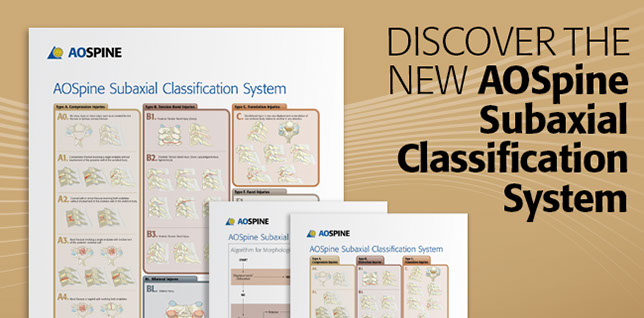AOSpine Member Representative Elections
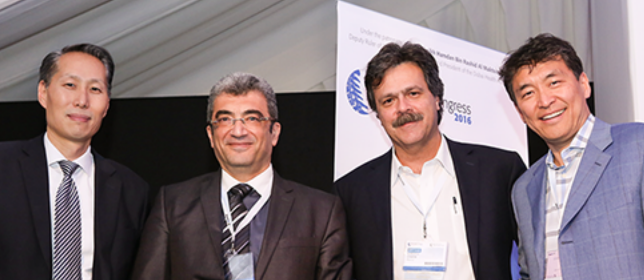
Newly elected AOSpine Member Representative Alaa Ahmad (second from left) with Nom Com Chair Jeff Wang (left), Nom Com member Roberto Chapa (second from right) and AOSpine Chair Dan Riew (right).
Alaa Ahmad was elected as the first ever AOSpine Member Representative by the voting members at the Member Assembly on April 16, 2016, at the Global Spine Congress in Dubai. In this newly created role he is representing the members and their interests in the AOSpine International Board (AOSIB).
He has already joined the AOSIB as Member Representative Elect, and will start his official term as Member Representative with voting rights after the Global Spine Congress in Milan in 2017.
To get in contact with the Member Representative send an email to: mr@aospine.org
Alaa Ahmad commented:
"I feel honoured and touched and I'm very much looking forward to this new role. I am delighted that that the AOSpine members have elected me as their first Member Representative. AOSpine for me stands for accepting and respecting diversity, and for sharing knowledge and experiences to improve the level of knowledge for all of the surgeons around the world."
Alaa Ahmed is a citizen from Palestine and works as a pediatric orthopedic surgeon in Palestine. He chairs the orthopedic surgery at the only medical teaching hospital in Palestine, Annajah University Hospital, with a parallel appointment as associate professor of medicine. He also holds an adjunct assistant professor of medicine appointment at the University of South Carolina in Charleston. The majority of his work is in spinal deformities, with a special interest in early onset scoliosis especially with the rib construct and vertebral modulation He's currently working on expanding spinal surgery services in Palestine and on improving access to pediatric orthopedic services more generally.
The Member Representative position
The Member Representative is representing all AOSpine members and will give them a voice in the AOSIB. The next election for the AOSpine Member Representative will be held at the Members Assembly at the Global Spine Congress Milan from 3-6 May, 2017.
The Member Representative will serve for two years—one year with elect status (guest without voting rights), and one year as a full member of the AOSIB with voting rights.
Eligibility to become AOSpine Member Representative
All AOSpine members who have been a continuous AOSpine member for a minimum of 4 years are eligible to apply for the position. In addition to being an outstanding, internationally recognized spine surgeon or spine researcher, the eligible candidates must already have shown their commitment to AOSpine, be passionate about developing AOSpine and willing to devote a significant amount of time and travel without fiscal reimbursement to this function.
Member Representative Application
The application process will be started in late 2016. Information for the application process will be sent to all AOSpine Members later this year.
Who can elect the AOSpine Member Representative?
All AOSpine members that have been members/members plus for at least 3 consecutive years and who have attended one Global Spine Congress in the last 5 years will be eligible as voting members.
If you have any questions with regards to the Member Representative position and the application procedure please let us know (e-mail address info@aospine.org)
Bryan Ashman elected as new
AOSpine Education Commission(AOSEC) Chairperson
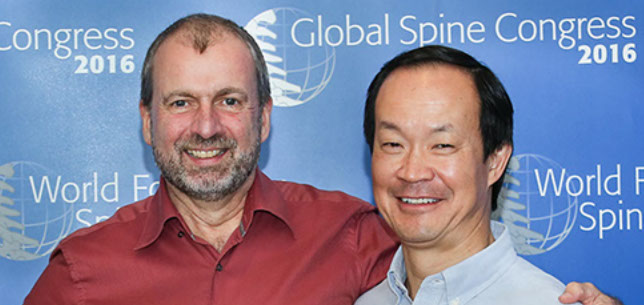
New AOSpine Education Chair elect Bryan Ashman (left) with
the current Chair Mike Grevitt.
Bryan Ashman was elected as new AOSEC Chairperson by the members of the International and Regional Boards at the Global Spine Congress in Dubai in April 2016. In his function he will represent AOSpine Education on the AOSpine International Board. He will join the AOSEC as Chairperson Elect on July 1st, 2016, and start his official 3-year term as Chairperson on July 1st, 2017.
Ashman commented on his vision as the new Chairperson of AOSEC:
"Apart from continuing the great current work from Mike Grevitt, I'd like to widen the focus for education. I'd like to concentrate on innovation on one hand, and by going back to basics on the other hand. My vision is to pursuing the management of common spine problems in developing countries and build courses and teaching modules around these topics. "
He describes his career path as one that has grown and advanced continuously into the direction of AOSpine, rather than coming from AOSpine. He started as a full time surgeon in practice who gradually took over education as a role in his day-to-day work, reaching a new milestone by becoming the AOSEC chair.
In his opinion the biggest benefit of AOSpine Education is that AOSpine is a truly international network of spine surgeons that offers the opportunity to exchange knowledge with peers from all over the world, who are very enthusiastic about their work and but face very different challenges in their daily lives as spine surgeons.
Education for surgeons is Bryan Ashman's passion and something that lies very close to his heart. His contributions to AOSpine Education are remarkable. He has been involved in AOSpine education since 2005 and has participated as a faculty member in over 50 courses around the world. Bryan Ashman represented Asia Pacific on AOSEC for 3 years before joining the International Board as Chairperson of the Region for a further 3 years. During that time, he adopted the original AO Principles for the AOSpine activities and wrote the defining statements. He also led the Curriculum Taskforce in developing and disseminating the AOSpine curriculum. His work has been recognised with three awards for excellence in education.
Bryan Ashman is also passionate about education for himself in order to improve people's learning experience. Besides working in his position as Clinical Director of Surgery at Canberra Hospital in Canberra, Australia, he's currently completing a Master's degree in Surgical Education with his final thesis based on research into factors that motivate spine surgeons to learn new surgical techniques, such as the benefit of modern apprenticeship.
The handover process has already started between him and the current AOSEC Chairperson Mike Grevitt. When asked what advice he would give to Bryan Ashman, Mike Grevitt said: "Education has a lot of hopes and expectations attached to it. My advice is to Bryan to reach out to people and engage with them. As AOSpine Education is such a big portfolio, the biggest challenge will be to manage priorities and focus on key deliverables. "
Ali Haghnegahdar is the winner of the Germán Ochoa Traveling Fellowship 2016
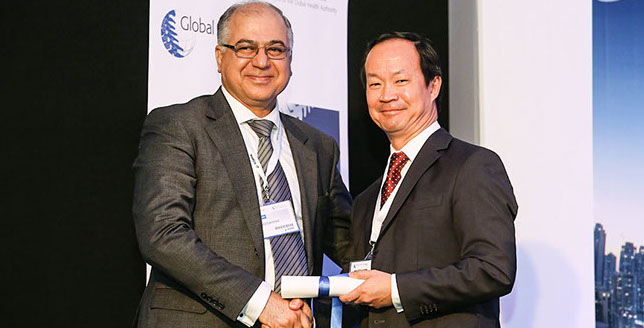
Ali Haghnegahdar, winner of the Germán Ochoa Traveling Fellowship 2016 and current AOSEC Chairperson Mike Grevitt
The fellowship, which was created to honor Germán Ochoa’s unparalleled dedication to AOSpine and his countless achievements, offers a unique opportunity for a senior AOSpine faculty member to spend up to 4 weeks at a spine center of their choice. The main ethos of the fellowship is that the selected member would act as an "ambassador" promoting AOSpine as a global community and a leader in spinal education. Members of the AOSpine Education Commission scored each applicant according to specified criteria, in addition to faculty merit and their motivation letter.
At the Global Spine Congress in Dubai, Ali Haghnegahdar became the second recipient of the fellowship award, for which a high number of quality applications were received.
Mr. Haghnegahdar started his experience in AOSpine as a participant at Comprehensive Spine Course in Dubai in 2005. After a decade of growing and learning with the AOSpine family he became Chairperson of the Davos master course 2015.
Since 2005 he has attended over 30 AOSpine Events worldwide in various functions such as Chairperson, Educational Advisor, Faculty or participant.
Education has always been very important to Ali Haghnegahdar. He commented:
"It doesn’t mean educational improvement is ended after this long history of learning and teaching. There is no doubt or hesitation for me to be a participant, a fellow or a trainee at AOSpine events and programs. Since medical sciences are ever changing, we need to constantly keep updated ourselves. We, AOSpine members, need to get connected andimprove our skills and the art of spine surgery. There is significant hunger for learning and research in the Middle Eastern region and we need leaders and role models to respond properly to this desire. I would like to express my gratitude to the AOSEC for creating this great learning opportunity. "
The scope for the German Ochoa fellowship varies according to the aspirations of the awarded winner. Visitation can be to established and renowned spine centres in developed health systems. In this role the expectation is that links will be created with non-AO colleagues with potential for future collaborations. Alternatively, time may be spent in less developed economies where the focus lies in teaching and supporting of local educational initiatives.
Criteria for the application of for the fellowship were the following:
- Member of AOSpine
- At least 5 years of teaching experience with AOSpine
- Completion of AOSpine's Training for Chairpersons program
- Experience as a Chair of an AOSpine educational event
- Motivation letter describing the applicant's personal contribution to and passion for surgeon education, specifically with AOSpine, and how the applicant will benefit from the fellowship experience and through it bring even more value to AOSpine's educational activities
Applications for the 2017 Germán Ochoa Travel Fellowship can be submitted as of late 2016. A separate announcement will be sent out to all AOSpine members.
Global Spine Journal Award winners
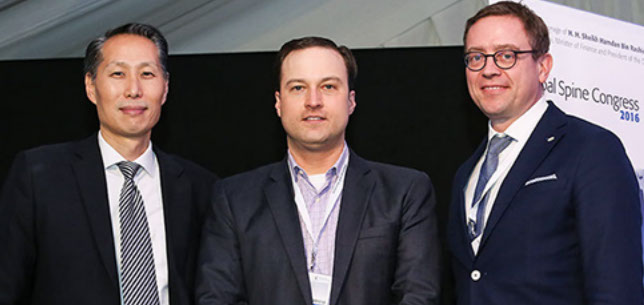
Global Spine Journal Best Reviewer Award winner Justin Smith (center) with Editors-in-Chief Jeffrey Wang (left) and Karsten Wiechert (right)
The winners of the Global Spine Journal Awards were announced at the Global Spine Congress in Dubai.
Best Clinical Paper:
A Randomized Controlled Trial Comparing Transforaminal Lumbar Interbody Fusion and Uninstrumented Posterolateral Fusion in the Degenerative Lumbar Spine
By: Kourosh Jalalpour, Pavel Neumann, Christer Johansson, Rune Hedlund
Best Basic Science Paper:
Annulus Fibrosus Can Strip Hyaline Cartilage End Plate from Subchondral Bone: A Study of the Intervertebral Disk in Tension
By: Christian Balkovec, Michael A. Adams, Patricia Dolan, Stuart M. McGill
Best Reviewer Award: John Devine, Andrei Joaquim, Justin Smith, Christof Birkenmaier
The Best Paper Awards are awarded based on the following criteria:
- Original research papers only
- Total number of downloads
- Total number of citations
- Highest rated Papers
- Originality of paper’s topic
- Rankings
The Best Reviewer Awards are awarded based on the following criteria:
- Reviewed papers in the year of consideration
- The number of reviews completed during that year
- The quality of the reviews submitted
- Their average reviewer ranking score
If you would like to be considered for the 2016 Best Paper Awards, please submit your paper at www.editorialmanager.com/gsj
If you would like an opportunity to win the GSJ reviewer award and you are not yet a reviewer, please email Managing Editor Danielle Lieberman.
How to Write, Publish, and Review a Paper—GSC Members-Only Session
From study results to submission, this article highlights the key points in writing a good manuscript.
On two days, as part of the Global Spine Congress AOSpine Members-Only Sessions, Global Spine Journal Editors-in-Chief Jeff Wang, Jens Chapman, and Karsten Wiechert led a session for AOSpine members on "How to Write, Publish, and Review a Paper." Drawing upon their expertise as Editors-in-Chief (EiC), as well as from their own personal experiences, they offered the attendees insight and helpful tips on what it takes to writing a good manuscript, and what makes a manuscript successful.
The basis of a good paper—a solid study question
In order to get research published, there are a number of points to consider. According to EiC Jens Chapman, who is in charge of the Evidence-Based Spine-Care Journal (EBSJ) section, crucial elements for a good manuscript for a research study are: a good question, a clean methodology, stamina, and crisp writing. The most difficult but also essential part of a paper, however, is to have a solid study question around which the paper and the case can be built.
Chapman emphasized that the manuscript should be tidy, clear, and complete, and that the results should be verbalized concisely. The paper should provide information for the reviewer about what was found, what the surprises were, the limitations and how they compare, and why. Last but not least, the paper should explain the impact of the study.
Keep it simple
The study question must be broken down into the following five questions: who, what, why, when, and where. In order to specify the question further, the PICO Principle (Population, Intervention, Comparator, Outcome) should be applied. Chapman emphasized that the content of the paper must encompass answers to all of these questions, without giving too much and potentially irrelevant information.
Once the question has been further specified, and the literature studies have been concluded, the study design must be defined. In order to measure and analyse, it is important to measure the patient characteristics, treatment, and outcomes. While doing this, Chapman suggests to constantly check if the data will answer the study question given the study design, and allow for control of potential confounders.
Consider timing and biases
When writing a paper, timing is crucial and should not be underestimated. Hence, the author should be aware of how timely the topic is, and how quickly it needs to be published. Also, authors should consider how much time is needed from concept to publication, the timing of the different measurements, how long the follow-ups should be done, and for what outcomes.
Another very important topic when publishing is bias. Does an author openly acknowledge possible biases, and what efforts were made to reduce them? Critical checks need to be made in the following areas: patient selection, allocation of treatment, blind or independent assessment for important outcomes, the use of reliable data, defined outcomes, if co-interventions were applied equally, a patient follow-up rate of 85%+, adequate sample size, controlling for possible confounding, and RCTs: process and concealment; ITT.
One of the common sources of bias is a loss of follow-up. Incomplete follow-up biases results when the dropout rates between groups differ, or when patients who drop out differ from those who don’t. Effect estimates may be erroneous and therefore statistical significance can be misleading. This threatens the internal validity of the study, as inferences from the study may not be valid. In order to calculate the loss to follow-up, the correct denominator is crucial. But how can one stay in contact with the patients, especially if they live far away and travel is expensive? Chapman openly admitted that it is sometimes not easy to stay in touch with patients. He suggests that the methods should be adapted to the different circumstances and that new and innovative ways should be explored, such as through social media.
Once you've got all your ducks in a row—do's and don'ts for writing a scientific paper
Global Spine Journal (GSJ) EIC Jeff Wang provided the attendees with useful tips about what should be considered when writing a paper and what has worked for him. The insights were based on his own personal experiences as both a reviewer and author of papers.
He stated that one of the most crucial points is to keep excellent records in the first place. The introduction of the paper should ideally be a single paragraph, which captures the attention of the reviewer quickly. The first few sentences are very important, as they tell the reviewers what they can expect to find in the paper. All strategic and relevant information should be included there. The author should state what makes this paper different from other studies, and why, and end the introduction with a clear objective of the study. The paper should be kept clear, concise, and anonymous, and have a conclusion that is not overstated.
Put yourself in the reviewer's shoes and leave a good first impression
Wang emphasized that it is important to keep in mind that the reviewers are people who do this review work voluntarily, and who most probably have to review a number of papers. Hence, the reading of the paper should be made as easy and convenient as possible. Requiring reviewers to search for key information should be avoided. All relevant information should be included in the appropriate areas in the first place.
Before submitting the paper, it is essential that it is formatted properly. Wang highlighted that the author should read the instructions for submissions and follow them carefully. If English isn't the author's first language, a proofread of the paper should be done by an English native speaker. If this is not possible, at least the spellcheck function should be used, in order to avoid misspelling of basic words. He also suggested that the author writes a strong cover letter, thanks the reviewers for their work, and uses appropriate, humble language.
After submission—the review process
GSJ EIC Karsten Wiechert pointed out that once a paper has been submitted, a very standardized review protocol is followed. As a first step, the manuscript is completely blinded. In a second step, the manuscript undergoes a technical check with regards to format and content, including a check with plagiarism software. As a next step, three main reviewers and three alternate reviewers are assigned, according to their area of expertise, and cross-referenced with the topic of the manuscript. All reviewers are longstanding experts in their field and are active researchers and/or clinicians. Before beginning the review, the reviewer assesses his/her own competencies and qualifications in the specific field, and if necessary rejects the review assignment.
The reviewers will review the manuscript according to the following key points and questions:
- Why was this study performed?
- How was this study performed?
- Are the outcome measures and analytical methods appropriate?
- Are the conclusions supported by the data shown?
- What is the overall significance of this study?
Based on these points, the reviewer will accept the paper, ask for minor or major revisions, or reject the paper. If additional expertise is needed, or if there are conflicting review decisions, an additional review might be invited.
What if your paper has been rejected?
The EiCs of the GSJ stated that almost no single manuscript passes the review process unchanged. While an author may think that his/her manuscript is flawless, he/she may not be aware of the immediate goals of the journal that they want to be published in.
What is the strategy and main goal once the author receives his/her paper back from the reviewers and it needs minor or major revisions? The GSJ EIC suggest that one should not give up just yet. This is a great chance to get the reviewers on the author's side. A detailed review is an opportunity to show compliance and to make the manuscript better. Authors shouldn't be offended by the criticism or take it personally. Instead, they should take the time to address all reviews concerned in a reasonable manner in a positive language, with a detailed explanation. Ideally, the authors should include the reviewers’ statements by "copy and paste" when they add the changes. Equally, if the author decides not to make a change or edit, he/she should politely state why.
Once the paper has been accepted, an extensive production protocol is followed until the paper is finally published online.
For more information and support for publications in Global Spine Journal, please contact Managing Editor Danielle Lieberman.



Globals Spine Journal Editor-in-Chief Jens R. Chapman (USA) explains the crucial elements of a good manuscript for a research study during the Members-Only Session " How to Write, Publish, and Review a Paper."
Global Spine Journal Editor-in-Chief Karsten Wiechert talks about the paper review process.
Members of the Global Spine Journal Editorial Board (from left to right): Deputy Editor K.V. Menon (Oman), Editor-in-Chief Karsten Wiechert (Germany), Managing Editor Danielle Lieberman (USA), Editor-in-Chief Jens R. Chapman (USA), and Deputy Editor Keita Ito (Netherlands)
3 - 3
<
>
AOSpine Knowledge Forum Trauma launches the AOSpine Subaxial Classification System Toolkit
During the Global Spine Congress in Dubai, the AOSpine Subaxial Classification System Toolkit was launched.
A unified classification system
The AOSpine Subaxial Classification System was developed to meet the need in spinal surgery for a unified classification system. This classification is a result of a systematic assessment and revision of the Magerl classification, and incorporates both fracture morphology and clinical factors relevant for clinical decision making. The Subaxial Classification toolkit follows the Thoracolumbar Classification toolkit, which was launched at the Davos Courses 2015.
The toolkit, consisting of a pocket card and poster, provides an algorithm for morphologic classification and illustrates the different types of fractures as well as their descriptions.
The three types of fracture injuries are as follows:
Compression, or "type A" injuries
A0. Minor, nonstructural fractures
A1. Wedge-compression
A2. Split
A3. Incomplete burst
A4. Complete burst
Distraction, or "type B" injuries
These are more severe than "A" type injuries, and focus on significant separation of the spinal elements.
B1. Posterior tension band injury (bony)
B2. Posterior tension band injury (bony, capsuloligamentous, ligamentous)
B3. Anterior tension band injury
Translation, or "type C" injuries
Facet injuries, or "F" injuries
F1. Nondisplaced facet fracture
F2. Facet fracture with potential for instability
F3. Floating lateral mass
F4. Pathologic subluxation or perched/dislocated facet
BL. Bilateral injuries
Dedicated AOSpine classification website
For more detailed information on this classification system and how it was developed, please visit the AOSpine Classification website, where you will also be able to download the thoracolumbar and subaxial toolkit.
Please visit: www.aospine.org/classification
We would like to cordially invite you to join our educational highlight, the Davos Courses, which will take place from December 12–14, 2016 in Davos, Switzerland. An extraordinary learning experience and excellent networking opportunities in the most inspirational of environments await you.
Following the wishes of our extensive community, the Davos Courses' format is focused on interactive, case-based learning, which is directly related to our daily practice.
At the Davos Courses 2016, you are able to personalize your program by selecting the modules with the topics that are most relevant to you:
- Adult Deformity
- Cervical Degenerative Including Complications
- Lumbar Degenerative Including Complications
- Trauma
- Tumors and Infection
Each day features one 1.5 hour practical exercise session.
Davos 2016 chairpersons
- Adult Deformity: Emiliano Vialle, Latin America
- Cervical Degenerative Including Complications: Mohammed El-Sharkawi, Middle East
- Lumbar Degenerative Including Complications: Bharat Dave, Asia Pacific
- Trauma: Rick Bransford, USA
- Tumors and Infections: Claudius Thomé, Europe
NEW: The course duration has been reduced to three days.
NEW: Two-hour lunch break
NEW: Meet the Expert Sessions: the good, the bad, the ugly—a case that taught me a lesson.
Gain tips and tricks from some of the most experienced spine surgeons in the world in small interactive group discussions. A distinguished panel of faculty will present challenging cases that provided learning points, new insights or future avoidance strategies. This will be a unique opportunity that will appeal to all Davos participants.
(Spaces are limited and are given on a first-come, first-serve basis. On-site registration only.)
New in Davos in 2016: Advanced Level Simulated Bioskills Courses—Microsurgical Decompression and Fusion Procedures in Lumbar Spine
At this year's Davos Courses, we will also feature two innovative simulated bioskills courses (one on December 11–12, and one on December 13–14). The focus will be on the latest teaching technology and a hands-on session at the bioskill simulator. The teaching level will be exceptionally high, with a 3:1 ratio between faculty and participants and an individual teaching session of 1:1 training. Participants attending either of the two courses, have the opportunity to observe the Davos Courses Masters' level modules on Monday or Tuesday, depending in which bioskills course they participate in.
These courses are designed for advanced level spine surgeons with five years or more experience in spine surgery. The bioskills courses will be led by international faculty and key opinion leaders.
Register now for the AOSpine Advanced Level Bioskills Courses via our website.
AOSpine Davos Courses—an extraordinary experience
Benefit from the opportunity to meet and interact with world-renowned spine experts and profit from their extensive knowledge and experiences in the field of spine surgery at the AOSpine Davos Courses 2016. At the event, you will be able to socialize with old and new friends and colleagues, and extend your network within the AOSpine family.
Places available on each module are limited, so register for the Davos Courses. AOSpine Members receive a 300 CHF price reduction on the registration fee.
Download the AOSpine Davos Courses Preliminary Program here
We look forward to welcoming you in Davos in December for an exceptional program and learning experience!
For more information, visit: www.aodavoscourses.org
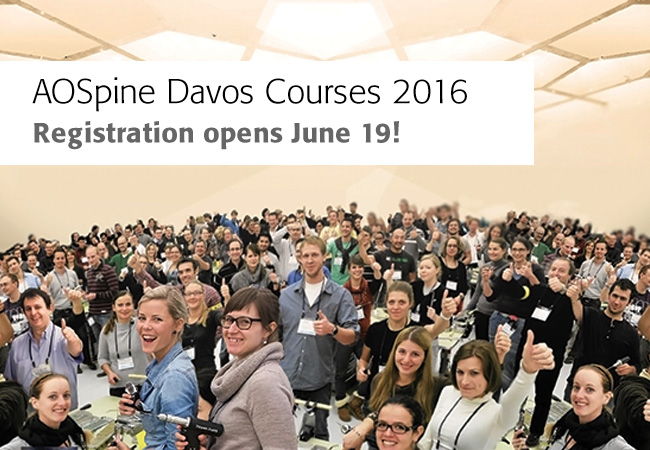
Davos Courses 2016—Educational Highlights and Other Novelties
Medical Device World
Share for better patient care!
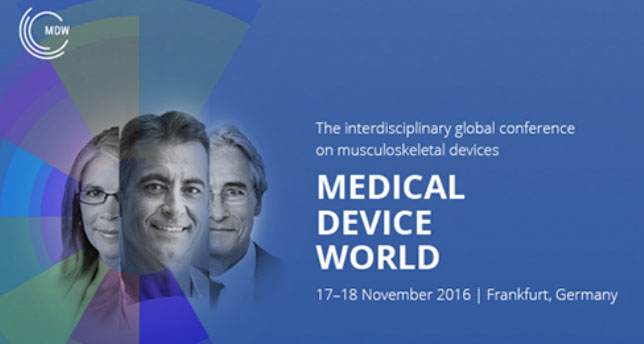
The MEDICAL DEVICE WORLD, the first interdisciplinary global conference on musculoskeletal devices will be launched on
November 17–18, 2016. Stakeholders from every corner of the medical device world will meet in Frankfurt, Germany to discuss the latest trends and issues in musculoskeletal device development, regulatory affairs and health economics. Surgeons, researchers, MedTech industry, regulators, notified bodies and healthcare professionals will share their expertise and participate in a much needed interdisciplinary discussion.
Why you should attend
- Share your hands-on experience in the development and use of musculoskeletal devices
- Learn about the impact of new regulations on research, everyday hospital life and patients
- Get an inside view on 3D printing of patient-specific implants and bio-tissues
- Discuss health economic aspects, e.g. Health Technology Assessment (HTA) and its limitations
- Profit from interdisciplinary knowledge transfer with regulators, notified bodies and industry
- Expand your professional network
- Influence the quality of future patient care!
Please visit our website for more information www.medicaldevice.world
Be part of the first global interdisciplinary conference on musculoskeletal devices and register now to benefit from the early bird discount of
€ 400 off the conference fee! Furthermore, special discounts are available for surgeons, researchers, hospital representatives and non-profit organization.
MEDICAL DEVICE WORLD - Join us and share for better patient care!
An initiative of the AO Foundation.
